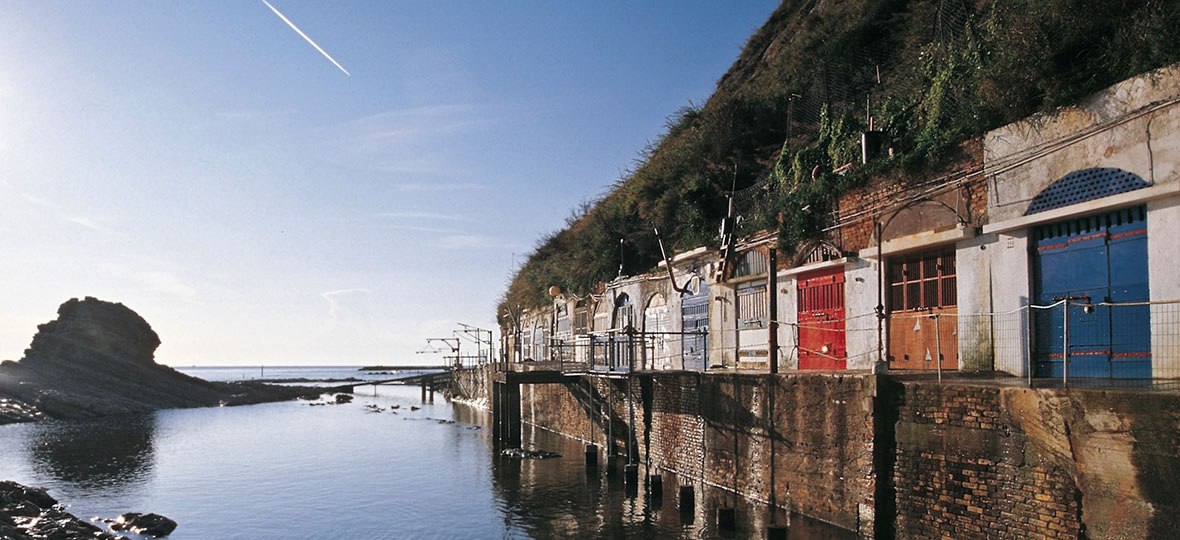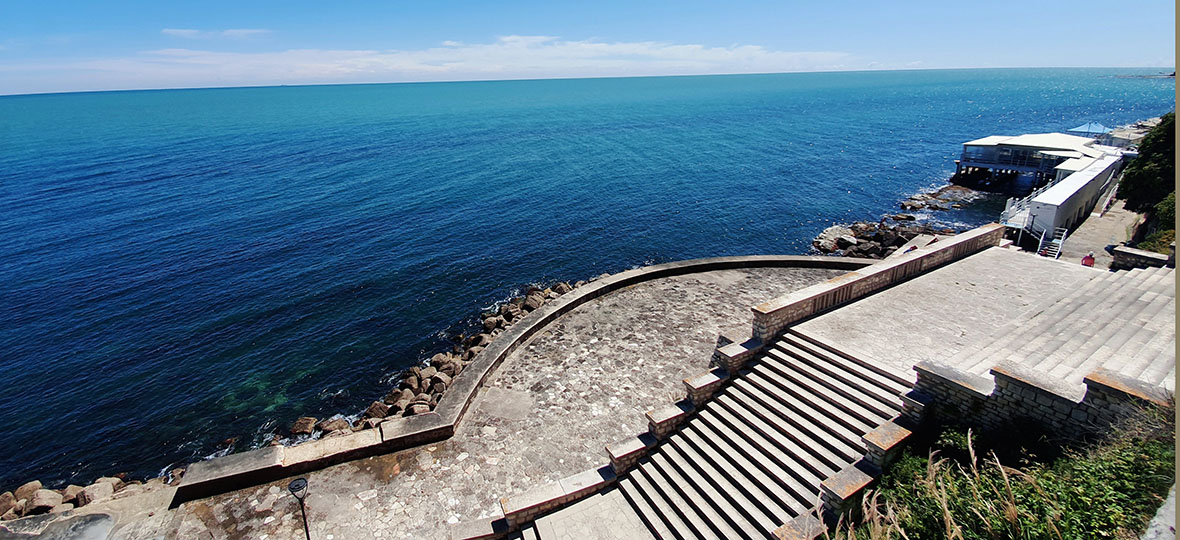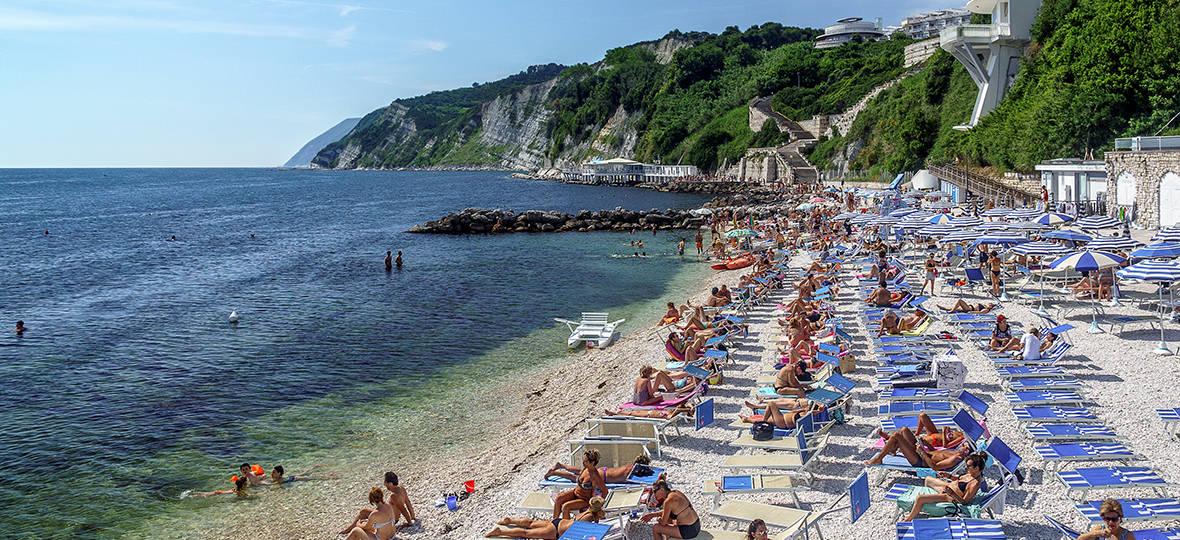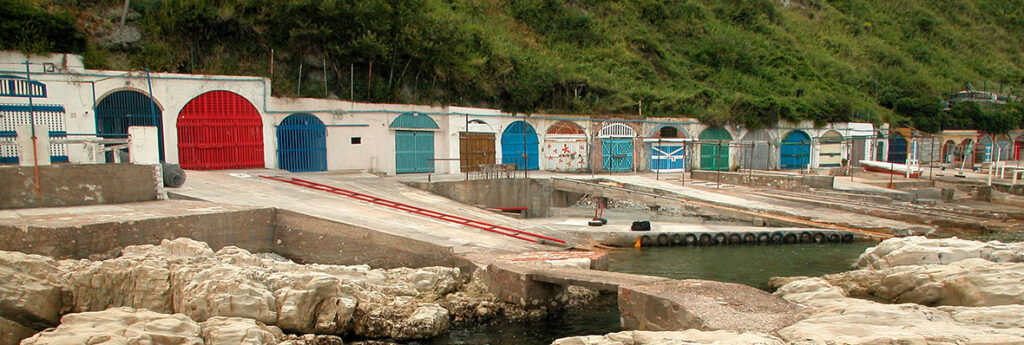A few steps from the central streets of Ancona – one of the most beautiful and unique places in Italy, is something remarkable to behold. At the base of the white cliffs of Conero is Passetto, a gorgeous rocky beach that extends for about a kilometre. Rather surprisingly there’s also more than 100 caves. These caves were excavated in the late 1800s and dug deep into the cliff face, using only hand chisels, and provided shelter for small fishing boats and related on-board equipment.
It’s a special place, which began its life in a parallel world: here the fishermen of another era would gather and go to sea in a fleet of small fishing vessels. Their families would congregate on the beach and await the return with a catch that needed skinning and gutting.
With the passage of time, a fishing community developed, and deep caves were excavated into the cliff, enabling the fisherman to safely secure their boats and tools.
The coast, at this point, is dotted with colourful caves
The caves are still alive today and have been reimagined by the fishermen’s offspring, and the generations to follow.
While some of the caves are still used for their original purpose – the hereditary owners (known as Grottaroli) have changed the original purpose of these once ‘boat garages’.
They’ve made improvements, converting them into adorable and colourful little beach cabanas, complete with electricity, running water, kitchenettes, and colourful wooden entrance doors.
Now they are a refuge for the hot summer months, enlivened by eating fresh fish and napping in the sun.
Original boat houses have been converted into cabanas
In the evenings, the caves turn on their abundance of lights, which gives it fairy-tale ambience. All of which goes to making the Passetto Caves unique, magical, and utterly enchanting.
The various colourful wooden doors, at the entrance of Passetto’s artificial caves, are striking works of craftsmanship. Some are intricately carved, others look like large garden gates, painted white, some cobalt blue, other acid green and a few are barely holding onto life.

Picture postcard village are a dime a dozen in Italy, as are primeval churches and ancient buildings, but these caves are unique.
A few of the cave doors were open so I could see inside – some were furnished with an eclectic mix of salvaged material, majolica tiles for flooring, wooden sleepers that were at one point used to pull boats ashore, and salvaged furniture which have been bizarrely repurposed. Others were kitted out to eat and entertain, containing a selection of chairs and tables, a stove to cook on, a bar fridge for the vino, and an obligatory espresso machine. In all it’s a treasure trove of sea, wood, colours, and creativity.
Seated outside their caves families were enjoying large seafood meals, caught straight from the peacock blue Adriatic just metres away. On rare occasions one of these caves come on the market for sale, but the price is steep, and comes with the warning that it’s exposed to the elements for half the year, and that they’re expensive to maintain. Yet it’s not difficult to see why they’re so highly sought after.
I stuck my head into the cave of Paolo Capici. He and his friend Stefano Ventrella, claim to live off the sea and off the grid and could think of no better way of life.
A little further along I meet Sauro Marinelli who descends from generations of fishermen and has been living off grid here most of his 73 years.
A few caves further along, directly across from “Rosa Dei Venti” (compass of the winds), painted on the pathway, a couple are opening their cabana, dragging chairs and tables out. My guide, Sergio, keen to introduce me to the locals got chatting.
Turns out Maurizio Bevilacqua is a television celebrity having starred in a famous Italian show for children. Now, he and his wife, Simonetta, spend most sunny days right here, sipping espressos, eating seafood, and contemplating life.
Sergio and I were invited to sit at Maurizio, whilst Simonetta prepared coffee then brought it to the table together with a plate of salted dark chocolate (which is catnip to me!). It’s always interesting to hear how people come to acquire prime real estate. Maurizio’s story was an interesting one. His football legend father convinced local workmen to dig him a cave when they’d finished erecting the cliff-top glass elevator they were contracted to do back in 1954.
“This is not normal, of course,” Maurizio announced, looking somewhat aggrieved. “This is what footballers could do back then. But in the late 1800s, it was all done by hand.” Whilst everyone at the table contemplated this vision, then sagely nodded in agreement, I laid into the chocolate and secured an open invitation for lunch any time I was next in the area.
• There are three groups of caves. Looking towards the Adriatic Sea, starting from the right, the first group of caves are located under the Piscina del Passetto, and is accessed by land via a small road next to the entrance to the pool.
• The central caves, just below the Monument to the Fallen of the Passetto, are accessed either by the monument’s staircase, or a panoramic glass lift, operational in the summer months. Alternatively, there is a steep path to the left of the elevator. On the beach, below the War Memorial and the lift, there is a bathhouse and a restaurant on stilts.
• The third group of caves are those on the left, and reachable via a small road off Via della Panoramica.
FESTIVALS
Festa del Mare – first Sunday of September
Hundreds of boats leave the port and go just a little way offshore, and honour the fallen of the sea, with a religious ceremony. Many related events are linked annually to this anniversary. The fair is held in the maritime district of Ancona and, as the grande finale, there’s a huge fireworks-show on the water.
The Coming – 8, 9, 10 December
This is celebrated in the evenings during which time large bonfires are lit in the city and suburbs, to light the way for fleeing gentiles (of 1200AD) to the Holy House in Loreto.

WHERE IS ANCONA
Ancona is the capital of the Le March region, which is bordered by Umbria and Tuscany. Le Marche has it all – seaside, rolling hills speckled with vines and olive groves, mountains, valleys, and glorious art towns. In fact, they say that all of Italy is encapsulated in this one region. It is also still relatively unknown, making it uncrowded, with an authentic feel. Here artisans and centuries-old crafts still prevail, and mystic-looking castles dot the landscape, where streets are bursting with flowering baskets.
Ancona is a sprawling city on the Adriatic Sea. It is the largest city in the Le Marche region with 103,000 inhabitants. Yet, when you’re in the historic centre, it feels like a small town.
ARTS & CULTURE
The Conero Riveria Riviera, with its noble cities and surrounding historic villages, are real-life masterpieces of Italian art. From the Romanesque to the Venetian art collections, to archaeology, they all jostle for your attention.
There are palaces showcasing farm wagons and discoveries made of past world explorers of distant lands; the Hill of Infinity which inspired the lyrics of L’Infinito; a 13th century bell-towered church, peppered with rare frescoes; the underground tunnels of Castlefidardo Castelfidardo; an Instagram’able flower-rich street named Costarella of Numana, which fishermen would use every day, descending the steep stairs to the port; and the Persiani Theater, also home to the Beniamino Gigli Civic Museum, defined as one of the greatest opera singers of the twentieth century.
Then there’s an abundance of parks – like the densely wooded Park of Villa Colloredo in Recanati (a town who also boasts a branch office of the WWF).
In the Biroccio Museum, in the hills of Filottrano, you’ll catch a glimpse of folklore, ox carts, and peasant life, of the early 1900s.
The jewel set in the rich centre of Ancona is the 11th century church of Santa Maria della Piazza. It’s one of Ancona’s most significant monuments to the history and art, (and regularly hosts concerts of sacred and classical music).
The classic La Rondinella Theatre in Montefano stands head-and-shoulders above them all. The white stoned 19th-century theatre is opulent and entirely incorporated into the city’s wall.
www.turismo.comune.montefano.mc.it/teatri-cms
FOOD & WINE
If nothing else you must sample just one tasty local dish – ‘Made in Conero’, known locally as Spaghetti Allo Scoglio. It’s claimed to be made by the nimble fingers of accordion makers of Castelfidardo, and by the sun-baked hands of the farmers who harvest the fruits of the earth.
Mid-price range: La Luna al Passetto for the best mussels in Le Marche.
Inexpensive but good: Street food typical in Ancona “Al chiosco da Morena”.
And then there’s the nectar of the Gods. Wines born in a restricted area within the province of Ancona – in particular the unmatched quality of a red wine named Rosso Conero. It’s high in tannin levels and perfectly enhance dishes based on meat, cold cuts and cheeses.

OUTDOOR PURSUITS
As you can well imagine, with a seaside location, Ancona offers all the sports imaginable – from horse riding along the beach, windsurfing, sailing kitesurfing, diving, hiking, cycling and a few lesser active pursuits like merely sitting in the sun, people watching. Going inland there are nature reserves that preserve indigenous flora and fauna, as is the case at Selva di Castelfidardo.
WHERE TO STAY
Along Ancona’s Conero Riviera you’re spoilt for choice between trendy hotels and B&Bs. Here I urge you to step away from the touristy places and look for a country house in an adjacent ancient village, or an agritourism stays immersed in greenery. This is where you’ll discovered the gentle hospitality of Italy – interesting people with stories to tell.
Put Florence on the backburner and leave Rome to the tourists, instead explore Ancona and the Le March region. Here you’ll discover sweet hills, ancient mountain-top villages and genuinely welcoming locals. The romance of it all is profound, you will lose your heart here. And don’t be surprised when your mind’s eye starts imagining valiant ladies, brave knights and stoic soldiers walking the same cobbled paths you’re treading, because they did and probably still do, if you lend your ear to the folklore.

